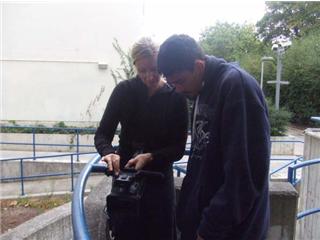originally written, 27th September, 2010.
London, summer 2004, I was a filmmaker looking for their next project. I had a newly found interest in visual anthropology thanks to the intellect and wit of a series of evening classes led by Dr. Charlie Gore at London’s Birkbeck College. An eclectic group of artists, activists, academics and colourful characters from all walks of life would meet once a week to discuss issues of representation and the politics of imagery. These sessions would be massively influential on what was to happen over the next five years.
The classes finished and after a few chance phone calls and a meeting with then Dr. (now Professor) Mike Wayne of Brunel University, I found myself being invited to submit a proposal for a practise based Ph.D. I had a somewhat limited academic background (an HND in Media Production from the then Plymouth College of Art & Design and a certificate in Social Anthropology from Birkbeck) but had made a few films so it sounded like a good idea.
I was neither an anthropologist nor an academic, I was a filmmaker who didn’t fit comfortably into the commercial thrust of broadcast media and who was losing the will to live from making educational and training videos, albeit to fund other more interesting and self-initiated creative projects. (There really are only a set number of ways you can film someone sat at a desk using a computer.) My passion was filmmaking, but limited to topics of my own choosing.
With 6 weeks to put a proposal together I asked myself “What am I interested in and what would I like to make films about?” Having been involved in ‘Chlorine’, a documentary about pool skaters in Southern California, I had already formed an interest in people who use architecture in creative ways, and I liked the punk ethos too. Salba, Reuler, Olson & Hackett would search out abandoned round bottomed pools and temporarily claim ownership, then play and carve out their lines of movement. It was all about the multiplicity, adaptation, comedy and sheer f*** you approach to authority and personal property. Risk, play and self expression were themes rife for future exploration.
Meanwhile in the UK, ‘Rush Hour’ featuring David Belle had hit the BBC screens in 2002 and the channel four documentary ‘Jump London’ broadcast in 2003. I knew there was something to this parkour thing that could find a place in my proposal. Alongside parkour was buildering, urban golf, buskers, the Situationists and anyone else who was involved in unregulated creative practices and re-appropriations of urban space. With a dose of academic theory from the usual suspects care of Foucault, Lefebvre, deCerteau and Chomsky, the proposal was accepted.
London, spring 2010, I’m still trying to complete the Ph.D, (excuses excuses…I’m part-time!) I’m currently writing it up. Parkour took over and became the focus of my research, leaving the other urban arts behind and with the realization that parkour was a world away from the Southern Cali skaters. During my research adventures I’ve made a few parkour led films, and encountered the good, the bad, mentally unstable and plain old ugly who’ve been involved in the parkour scene. It is however a scene that I remain optimistic and positive about.
After 5 years of research and a lot of time spent in the company of those with many years of parkour experience, (that’s you Mr. Vigroux! and others too) it is only recently that I feel sufficiently informed to present some of my insights and conclusions on the subject.
Filmmaking aside, I have had to do some academic writing with a serious tone because it is after all serious research… I’ve had access to and interviewed many of the key influential trailblazers and originators of the art including David Belle, Yann Hnautra, Chau Belle Dinh, Sébastien Foucan and many more in addition to those who feature in my films. They have all been very generous and supportive of my filmic and written adventures and I can only continue to thank them for this. Over the next couple of issues I’ll be sharing some of my views, conclusions and reflections on this art, (not in any particularly academic way or order) from its complex multiple narratives of the early years in Lisses and Sarcelles, to looking at what parkour is and isn’t, how to film it and what’s up with all this spectacle. Until then, it’s back to the writing for now, and a special thanks to my good friend Thomas Couetdic for helping me get access to the final piece of the puzzle.
Cheers, Julie

